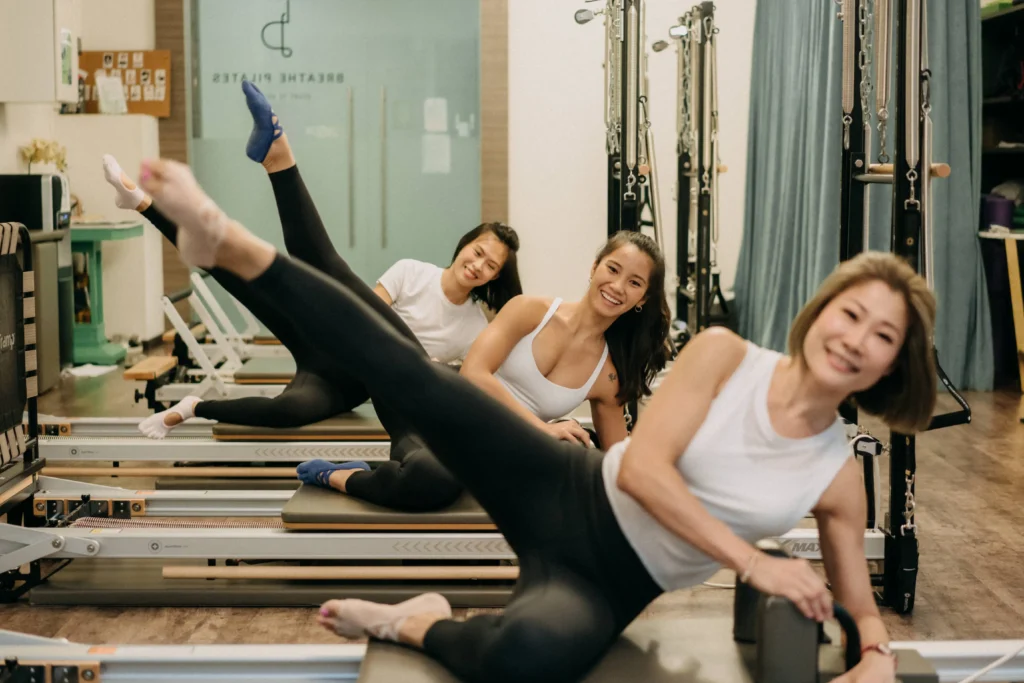We see many clients who are dealing with neck pain. Whether it’s from poor posture from the infamous tech neck, neck pain from an accident, injury or just how we use and move our body for work and daily life – chronic neck pain is literally a pain in the neck!
Pilates exercises done correctly are excellent for strengthening core muscles for support, which over time helps to reduce neck tension. However, Pilates exercises can also aggravate a neck problem if not performed correctly, by not understanding, or having the strength and flexibility needed to support the body well and keep the stress out of the neck.
Why Is My Neck Hurting During Pilates?
Our head is basically an 8-10 pound bowling ball sitting on a straw. If the ball is not well-balanced on the straw, the straw will lean or bend and the head will tip to funny angles striving to stay perched at the top of our body. At this point, some muscles are working too hard, and others are not pulling their weight. Over time, the body accepts this way of holding the head and neck as correct (whether it’s good or bad) and the pattern of muscle use becomes a habit – whether we like it or not!
The good news…It’s never too late to change a habit!
With a little effort, and having some new strategies to play with and practice, you can effectively reduce neck tension and neck strain quickly and easily just by paying attention to where you are holding tension and practicing better breathing habits during your Pilates exercises.
Top Tips To Help reduce Neck Pain During Pilates Exercises
Pelvic Floor
Effective use of the pelvic floor provides the anchoring at the base of the spine which is necessary for lift and lengthening that occurs during breathing. Without an active, engaged pelvic floor, it’s impossible to get the ribs to lift away from the pelvis, the neck to lift away from the torso, and the head to lift away from the neck!
Shoulder Depression
Our body is a system of levers and pulleys. One side goes down and the other goes up. So for our body, the shoulder blades doing down provide the leverage for our upper spine, neck, and head to lift up. If your shoulders are wrapped around your ears, chances are your head and neck are jammed in too close to your torso. Relax the shoulders down and you should feel your head shoot up another inch or two closer to the ceiling.
Breathing Techniques
Regardless of the exercise, good breathing habits are critical for opening the joint space in the neck and helping to lengthen the neck muscles to reduce neck strain and improve posture and body alignment.
In Pilates, emphasis is placed on inhaling to fill the back of the rib cage from the bottom to the top. In effect, what happens is as you fill the lungs with air, you are increasing the natural curves of the spine. This should happen from the tailbone to the top of the head. So your inhale helps to float the head up off the neck.
It is also important to keep the front of the neck and throat relaxed on your inhale
We notice many newbies to Pilates actually inhale through the torso and tense up so much through the front of their neck that the head actually gets closer to the body on the inhale! When this happens – the neck muscles are pulling the neck bones closer together (when things should be lengthening apart!) Watch yourself breathe in front of a mirror and see if you notice your neck get longer, or shorter as you inhale. Do you see the muscles in the front of your neck tense up on your inhale? Or do they stay loose and relaxed? Think about your neck and throat being an open tube that air can easily flow in and out of.
If you’re doing any exercise and you begin to feel stress or strain in your neck – STOP. It is better to take a break, then start to use muscles that shouldn’t be doing the work and continue to aggravate neck issues. There are hundreds (maybe thousands) of exercises that can be done without neck pain. The challenge is finding the right exercises for your body to start with, and continue to progress.
